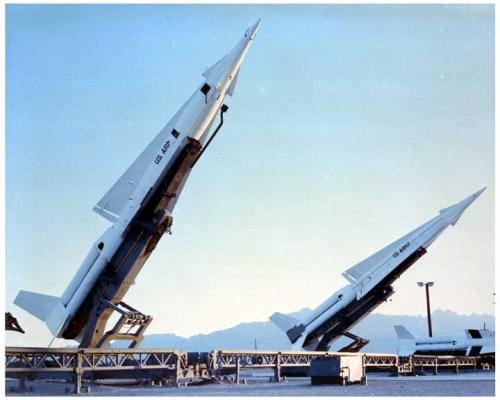小弟以前住老眷村
之前回老家時問過以前維修過F-100的老前輩
問他飛機裡有沒有在用用布包的電線
就回了
"那時候飛機上最複雜的電子裝備只有無線電....
不防火又會吸油的東西當訊號線
誰敢飛啊 狗屁"
然後就是近一小時的歷史故事時間......

那這張宣傳單代表著甚麼呢?
軍用機上的配線
通常只有料號
更早之前的飛機是沒見過
至少民6X年左右在台組裝的UH-1H
就沒見過神奇的布線了
之後產的就更別說了
也沒聽過這類的線需要屏蔽的

圖上最粗的是裝備的電源線(日期標示旁的那條)
有包像布的東西但是那個絕對不是布....
很多地方不要逼我出來戳
在美軍導彈的介紹文中所題及的承包商"西方電子"指的是否跟我們討論的是同一家公司呢?Directory of U.S. Military Rockets and Missiles
MIM-14
MGM/CGM-13
RGM-15
Copyright © 2001 Andreas Parsch
Photo: U.S. Army
M6 (MIM-14A/B/C) (exact model unknown)

Western Electric SAM-A-25/M6/MIM-14 Nike Hercules
The Nike Hercules was the only nuclear-armed surface-to-air weapon, which was operational with the U.S. Army. Development of an improved Nike missile began in 1952, with the primary goal to develop a missile with a significantly higher performance than MIM-3 Nike Ajax (then known simply as Nike), which could still be used with the existing Nike ground equipment. After it had been shown that the Nike Ajax could not be equipped with then existing nuclear warheads, nuclear armament became another goal for the new missile. The SAM-A-25 Nike B program was formally established in June 1953. As with Nike Ajax,
Western Electric was prime contractor, and Douglas was responsible for the missile airframe. The Nike B (renamed Nike Hercules on 15 December 1956) used many components of the Nike I (Nike Ajax). The booster consisted of four Nike Ajax boosters, and the original design used 4 of Ajax' liqued-fuel rockets as sustainer propulsion. However, the first flight tests with the liquid-fuel sustainer in 1955 proved very troublesome, and a solid-fueled sustainer rocket was eventually used. The first successful interception of a drone target occurred in 1956, and in 1957 the new solid-fuel sustainer flew for the first time. Nike Hercules used the same command guidance as the MIM-3 Nike Ajax, with essentially the same ground components.
The first production Nike Hercules missiles were delivered in 1958, and quickly replaced the Ajax on many Nike sites. By then, the Nike Hercules had been designated as Guided Missile, Air Defense M6. The M6 could be equipped with either an M17 (a.k.a. T45) blast-fragmentation warhead, or a W-31 nuclear fission warhead with yield selectable as 2 kT or 40 kT. The missile performance was such that even very high-flying bombers could not escpe the Nike Hercules. Capability against low-level targets remained rather limited, however.
Photo: U.S. Army
M6 (MIM-14A/B/C) (exact model unknown)
As the Nike Hercules began replacing the older Nike Ajax, work was underway to improve the acquisition and tracking radar capabilities to fully exploit the missile's greater performance. The major improvement in what was called the Improved Hercules system was the new L-band acquisition radar, called HIPAR (High-Power Acquisition Radar). The TTR (Target Tracking Radar) and TRR (Target Ranging Radar) were also improved, having better ECM resistance. The missiles of the improved Improved Hercules system were designated as M6A1. In June 1960, an Improved Hercules achieved the world's first successful interception of a ballistic guided missile, when a MGM-5 Corporal SRBM was shot down. The new radars were also far more compact than the original ones, which made moving a Nike site a least somewhat practical for the first time. Lastly, Improved Hercules introduced a viable surface-to-surface capability to the Nike system. The first Improved Hercules systems were installed at Nike sites in June 1961.
In 1963, the M6 and M6A1 missiles were redesignated as MIM-14A and MIM-14B, respectively. The MIM-14C (introduced in 1972) was a modified MIM-14B with an improved missile guidance section for higher manoeuverability and better ECM resistance.
Photos: U.S. Army
M6 (MIM-14A/B/C) (exact model unknown)
All in all, the U.S. Army established 145 Nike Hercules sites over the years. Production of the nuclear-armed missiles ended in 1964, and gradual phase-out of the MIM-14 began in the late 1960's. The Army originally planned to replace the Nike with the new MIM-104 Patriot missile, but this plan was not implemented in the USA. Therefore, after the last active Nike Hercules sites in the continental U.S. had been deactivated in 1974, there are no long-range air-defense missiles fielded in the U.S.. In Europe, the U.S. Army retired its last MIM-14 units in 1984, when the MIM-104 Patriot was introduced.
In total, more than 25000 Nike Hercules missiles of all wersions were produced, most being of the MIM-14B variant.
Specifications
Note: Data given by several sources show slight variations. Figures given below may therefore be inaccurate!
Data for MIM-14B:
Length (w/o booster) 8.18 m (26 ft 10 in); booster: 4.34 m (14 ft 3 in)
Wingspan 1.88 m (6 ft 2 in); booster: 3.50 m (11 ft 6 in)
Diameter 0.53 m (21 in); booster: 0.80 m (31.5 in)
Weight (w/o booster) 2505 kg (5530 lb); booster: 2345 kg (5180 lb)
Speed Mach 3.65
Ceiling 45700 m (150000 ft)
Range 140 km (88 miles)
Propulsion Booster: Hercules M42 solid-fueled rocket cluster (4x M5E1 Nike boosters); 978 kN (220000 lb) total
Sustainer: Thiokol M30 solid-fueled rocket; 44.4 kN (10000 lb)
Warhead M17 blast-fragmentation or W-31 nuclear (2 kT, 40 kT)
Main Sources
[1] James N. Gibson: "Nuclear Weapons of the United States", Schiffer Publishing Ltd, 1996
[2] Bill Gunston: "The Illustrated Encyclopedia of Rockets and Missiles", Salamander Books Ltd, 1979
[3] Redstone Arsenal Historical Information Website
Much additional information and lots of tidbits can be found at Ed Thelen's Nike Missile Web Site.
Back to Current Designations Of U.S. Unmanned Military Aerospace Vehicles
Back to Directory of U.S. Military Rockets and Missiles
原文取自http://www.designation-systems.net/dusrm/m-14.html還是將主題回歸到線材的聽感分享吧

好阿~

















































 )
)



 [/quote]
[/quote]













